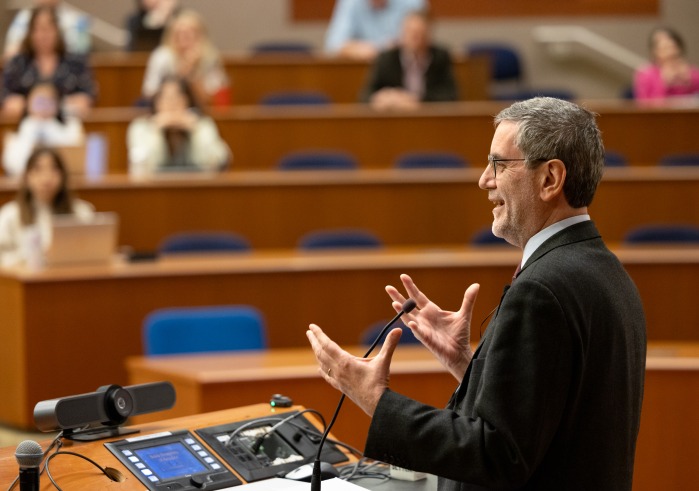'Every Human Being Can Contribute to Lasting Peace': A Conversation with Andrea Bartoli

Andrea Bartoli, president of the Sant’Egidio Foundation for Peace and Dialogue, executive adviser to the Soka Institute for Global Solutions (SIGS), and an SUA trustee, has worked as a scholar-practitioner in peacemaking for over four decades. He has been involved in conflict resolution activities in Mozambique, Guatemala, Algeria, Kosovo, Burundi, the Democratic Republic of the Congo, Casamance, Central African Republic, and South Sudan.
Bartoli recently shared some of his thoughts and reflections on peacemaking, global citizenship, and the role of SUA in today’s world.
Was there a specific moment or experience in your life that inspired your commitment to building peace, or did it stem from a more gradual realization over time?
In my case, there was certainly both. I joined the Community of Sant’Egidio in 1970, when I was 13. We started doing peace work in 1976, helping a friend in Mozambique. I was very young at that time, but I was participating in a team led by [now] Cardinal Matteo Zuppi and Andrea Riccardi, the founder of the Community of Sant’Egidio. There was a period of significant exposure to and engagement with peacebuilding between 1975 and 1992.
However, it was only when I came to the United States in 1992 that peacebuilding truly became a commitment. I started teaching at Columbia University, writing about peacemaking, teaching graduate students, and supervising theses. The scope of my work grew significantly. That was the moment in which the commitment grew into something lifelong that would become part of me and my identity.
Can you share a particularly impactful experience from your career that illustrates the power of dialogue?
What comes to mind is a fairly unexpected conversation that I had with [Visiting Assistant Professor of Peace and Conflict Studies] Tetsushi Ogata, who at the time was a graduate student and my research assistant at George Mason University, and Mô Bleeker, a very talented Swiss diplomat who is now the U.N. secretary general’s special adviser on the responsibility to protect. Tetsushi was working with me on a project about genocide prevention through training state officials.
The three of us were talking about what to do next, and we imagined an organization that brings together state and nonstate actors, civil society organizations, and international organizations to work on the prevention of mass atrocities. We connected with other people working in this space, and we co-created a platform for prevention, Global Action Against Mass Atrocity Crimes. I am still in awe of how the dialogue of three people could generate something that didn’t exist.
It’s very important for us to seek and cultivate these moments in which human creativity is allowed to flourish through interaction. I think dialogue can sometimes be constrained into an attitude of negotiation — “I’ll give you this, and you’ll give me that.” But dialogue, especially the way SUA founder Daisaku Ikeda engaged in it, always has a creative dimension.
“I am still in awe of how the dialogue of three people could generate something that didn’t exist. It’s very important for us to seek and cultivate these moments in which human creativity is allowed to flourish through interaction.”
As both a peace scholar and a practitioner of peacemaking, how does your experience on the ground enrich your scholarly work and vice versa?
I’ve made most of my career about moving practice to theory, which I think is a very important discipline. On the academic side, a lot of my scholarship and writing has to do with reflecting on practice. On the practice side, there is a strong risk of being limited by the multifaceted, challenging, and always moving environment of the practice. It’s very possible to look only at what is in front of you, especially if the situation is going in the wrong direction or if there is a moment of pressure that seems impossible to overcome. The scholarly work helps, because precedent tells you that many people have faced extremely constraining conditions and were able to overcome them.
Teaching was also a significant part of my becoming a scholar and professor. When you teach, you need to be mentally organized, explain clearly, and respond to questions from students. Teaching brings together the practice and the scholarship in a very special way. I think it’s a blessing whenever I can be with students. I’m always learning when I’m with them.
How do you see SUA’s mission aligning with the challenges we face today, such as climate change, inequality, and threats to democracy?
The mission of SUA — to foster a steady stream of global citizens committed to living a contributive life — aligns very well in that it is a long-term, implicit commitment. The mission is not an agitated, urgent, or violent intervention in a world that is wrong. It’s a perseverant, consistent, faithful, collective invitation and enterprise that responds to global challenges over time. And the response comes through the people who are living, invested in, and committed to the mission. On the board of the university, I frequently insist on the awareness that the world needs SUA exactly because we have challenges like climate change, inequality, and threats to democracy.
Through your work with the Soka Institute for Global Solutions, what innovative approaches to conflict resolution are being explored, and how can SUA students contribute to this work?
The nuclear abolition project is conflict resolution at the highest level. There is an element of nuclear abolition that has to do with the physicality of the weapons and the systems that discharge them. But there is another piece that has to do with the liberation of entire societies and humanity as a whole from the idea that everything is fundamentally organized by and oriented toward enmity and destruction; from the idea that we are such enemies that we must secure nuclear weapons and make sure everyone knows we have them so that no one dares confront us in life-threatening way.
SIGS is not a research center that is separate from SUA. It’s really embedded in the university and involves students in conversation, often with very experienced and senior people. Students have been exposed to extraordinary names in nuclear abolition, such as William Potter [director of the James Martin Center for Nonproliferation Studies at the Middlebury Institute of International Studies]. This makes students part of a much longer tradition and possible trajectory on that level.
Students are already contributing to SIGS. We have a group of students who help with all four projects: nuclear abolition, sustainability, PreK-12 global citizenship education, and peace and reconciliation in East Asia.
What do you think makes SUA’s approach to global citizenship education distinct?
I’m not sure there is another university that stresses global citizenship education so clearly. Usually, universities have a study center or a program within the larger organization. There may be some courses, professors, or initiatives. SUA is the only place I know where the university positions global citizenship as central to its mission and activities. In many other approaches, the idea is that global citizenship is an education problem that only educators are interested in. SUA is distinct in saying that global citizenship is not just for educators or for students during this specific period of their life. Rather, it’s a long-term commitment for everybody. You can be an economist, for example, and do economics differently because you see yourself as a global citizen. You will be a very different diplomat, mathematician, engineer, doctor, or researcher if you see yourself as a global citizen.
Can you recount your encounter with Daisaku Ikeda? What was most meaningful about that encounter for you?
I was just one of hundreds in a room at Columbia University when he delivered his 1996 address, “Thoughts on Education for Global Citizenship,” which gave SUA the founding values of wisdom, compassion, and courage. What I remember vividly is that Ikeda was completely free from the cultural insistence on money that is prevalent in the U.S. He was definitely traveling at another level. It was meaningful for me to see that the world is not just transactional, and we shouldn’t give up the hope that important words can be said and listened to. To me, Ikeda was also an expression of the resistance of the human spirit to the absurdity of uniformity, militarism, and violence.
What core principles do you think are most essential for fostering lasting peace, and how do you think we can apply them in our lives?
I don’t necessarily think in terms of core principles, but more in terms of a personal orientation or orientation of the spirit. There are four steps that have been helpful to me in different situations. They have to do with the way every human being can contribute to lasting peace.
The first step is to be attentive. There is no way that you can create conditions for lasting peace if you are not attentive. If we are sloppy or insensitive, lasting peace is just impossible.
The second one is to be intelligent. We are capable of understanding this world. Yes, this world is terrible and filled with contradictions, but we can understand the contradictions. We can understand the uncertainties, and we can intervene. The second step is really about being intelligent in understanding what we are attentive to.
The third step is to be reasonable. This means not adopting the logic of “I am right because I have the power to say so,” but rather, thinking more carefully, “If this is what my attentiveness and my intelligence tell me, can I reasonably set the course for a response that is positive for everyone?”
And then the fourth step is to be responsible. Being responsible means moving from “I” to a global “we.” Everything is not about me and what I do. I am responsible for everybody, and everybody is helping me to be who I am.
These four steps — be attentive, be intelligent, be reasonable, and be responsible — are very helpful steps for me that I think may help others as well.
